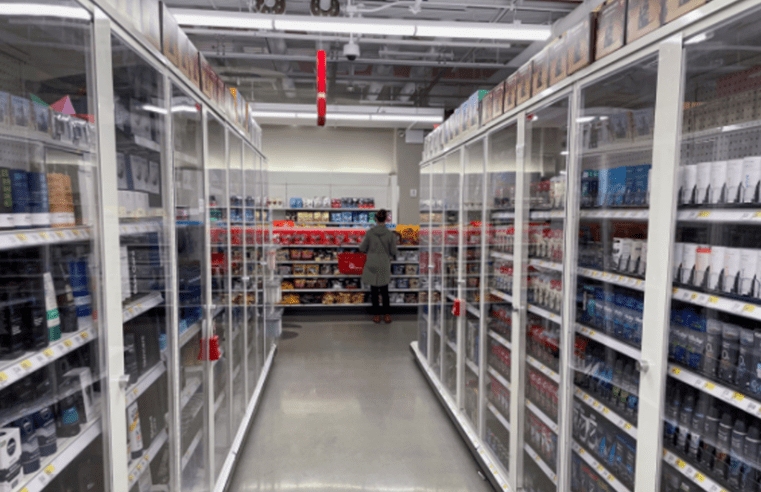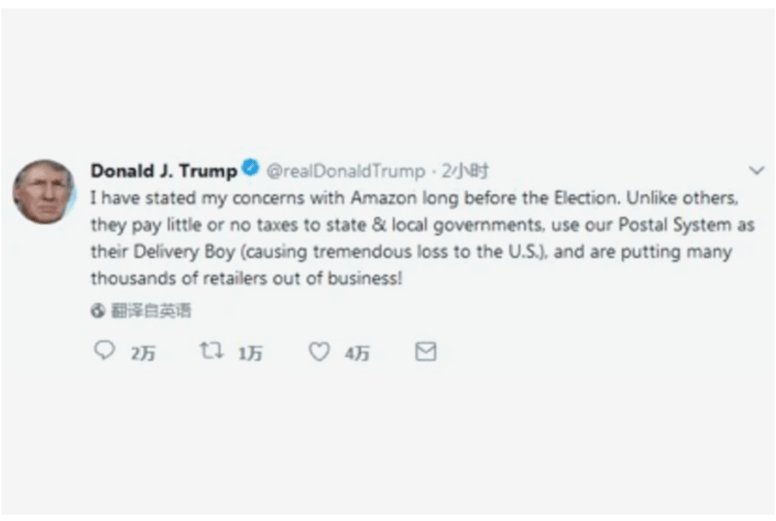Offline retail in the United States can’t hold it anymore

One day in April, Xiao Chen, a young Chinese in Chicago, went to Wal-Mart( 157.18 , 2.90 , 1.88% ) .
Suddenly, several big black men rushed into the supermarket, took out their bags and began to sweep the goods. Unsurprisingly, Xiao Chen and other customers silently made room.
Carrying full pockets, these people swaggered out of the supermarket, and one of them even made a face at the female cashier. The security guard did not move at all, but closed the door silently after they left.
The next day, Xiao Chen found out that this Wal-Mart was permanently closed.
01
Large supermarkets can’t stand it anymore
Fremont has been working as a picker at Wal-Mart since he was 21 years old. He was surprised:
“No one thought that Wal-Mart would close. We were born to buy things here, and never thought about whether it was open or not.”
But the hurricane of closures began in Chicago and swept through Walmart stores across the United States.
On March 11, after announcing the closure of four stores in Chicago, Wal-Mart spoke again, increasing the number of closed stores to 17 stores in nine states.
On the second day after the store closed, Fleming came to the store as usual. He only saw the empty shelves, the garbage that was too late to pick up, and the huge supermarket that was quiet.

“Closed store employees will receive 90 days of pay or the opportunity to work in another store,” Walmart said in a statement.
But stores across the region are closed, and continuing to work means traveling far away from home to new cities—something few employees do.
Wal-Mart is gone, leaving only dazed employees and a completely changed retail ecosystem.
In April, Wal-Mart further expanded its store closures. In May, the number of closed stores surged to 80, and it plans to continue to close 20 stores in the future.

▲Wal-Mart closed stores in April
( 20.27 , 0.26 , 1.30% )
Outside of Wal-Mart, more and more offline retail stores can’t handle it.
( 130.36 , 2.46 , 1.92% )
Among them, 2 closed stores are also located in New York, a city with dense population and high consumption level.
The clothing brand GAP is even more exaggerated. They stated that they will close about 350 stores before the end of 2023, and the number of cities occupied by their stores will decrease by at least 866.
It is a helpless move to narrow the business scope in time. After all, it is better to close the store than go bankrupt. Some brands want to recover their losses, but it is too late.
On April 23, American household goods giant Bed bath & Beyond filed for bankruptcy. Before the end of June, they will close the remaining 475 stores.
Bed bath&Beyond was founded in 1971. At its peak in 2019, the company operated more than 1,500 stores.
Although the company still has net sales of US$1.259 billion by November 26, 2022, its burdens make it difficult for the company-as of the end of the first quarter of 2023, the company’s total liabilities reached US$5.2 billion.
Not long ago, David’s Bridal, the largest wedding dress retailer in the United States, had just declared bankruptcy.
Those companies that once seemed too big to fail have verified a lyric: “Nothing lasts forever”.
Behind the tide of store closures, there is an important catalyst – “zero yuan purchase”.
02
Crazy “zero yuan purchase”
( 110.37 , -3.00 , -2.65% )
“Why buy something when we can get everything we want without spending money?”
Just ten minutes ago, the young man walked into a Nike store with his partner.
They wandered around in front of the new products, and sat down to try on the sneakers. After they were finished, the strong young man in the lead blew a whistle, and everyone rushed out the door.
Nike’s clerks paid attention to them without any surprise.
This is the “zero dollar purchase” in the United States. You can take any desired product in any store without spending a penny.
In 2021, several Chicagoans who were struggling to make ends meet during the epidemic walked into the supermarket and “took away” the food they needed to survive.
Afterwards, they were pleasantly surprised to find that they owned the goods, were not brought to justice, and did not need to pay back. As a result, more people joined their ranks.
The stolen and robbed goods have also developed from food and basic daily necessities to digital products, luxury goods, and even large refrigerators and color TVs that are not easy to carry.
( 193.97 , 4.38 , 2.31% )(860, 0.00, 0.00%)860 , 0.00 , 0.00% )

Large-scale theft and robbery have devastated supermarkets and specialty stores.
Wal-Mart said in a store closure statement that “zero dollar purchases” have caused millions of dollars in losses for stores in the Chicago area.
Another large American supermarket chain brand: Target, its chairman is full of resentment when the media accuses:
“In 2022, robbery and theft brought us a loss of 400 million US dollars. At the beginning of this year, the loss has exceeded 600 million. If no one cares, we will close 20% of the stores to stop the loss.”
According to statistics from the National Retail Association, the total number of “zero-dollar purchases” in the United States will exceed 100 billion U.S. dollars in 2022, and in 2021, this number will be 94.5 billion.
Such a blatant crime, why no one cares about it?
The answer is, hard to manage.
Under the laws of some states in the United States, shoplifting/robbing items with a value of less than $900 is not a crime. And if the clerk catches the “zero-dollar purchaser” without evidence, he may be sued for defamation.
Therefore, even if the businessman calls the police, the police have to wait for the criminal to move the goods out of the supermarket and confirm that the other party has committed a crime before arresting him.
But once they walked out of the store, these people rode their motorcycles and disappeared without a trace.
Shangchao, which wants to persevere, can only try to save itself.
For example, Wal-Mart has added cameras to many stores, put barbed wire on valuables, and installed a large number of glass windows.

But no matter how tight the defense is, it can’t stop thieves from thinking about it. As a result, the loss of supermarkets remains the same, and many kind-hearted customers, who are worried about safety and find it troublesome, also come less.
Under the catalysis of “zero yuan purchase”, the inflection point of offline supermarkets in the United States has been brought forward even more.
03
footsteps of the times
In March 2018, Trump, who was still President of the United States at the time, bombarded Bezos on social media.
In his view, Amazon has hurt retailers and cost Americans jobs.
As soon as the remarks came out, American news websites even received secret news that Trump might use federal antitrust or competition laws to curb it.

However, no one can stop the water from flowing downhill. The convenience and cheapness of Amazon means that the general trend is inevitable. Trump’s voice stirred up waves, but soon calmed down.
During the epidemic, Amazon and even the entire North American e-commerce grew more rapidly. In 2022, the revenue of the North American e-commerce market will reach US$1 trillion, making it the second largest e-commerce market in the world.
Among them, Amazon topped the list with the highest cumulative transaction volume.
Wal-Mart, which is depressed offline and suffers from “zero-yuan purchases”, has also found a new life online-in 2020, Wal-Mart’s e-commerce sales in the United States have surged by 97%, while offline sales have only increased by 9.3%. %.
The data agency Statista once conducted a survey: How long have the “millennials” in the United States not shopped offline.
The conclusion of the report shows that almost 80% of young people have no offline shopping experience for more than a month.
The downfall of offline supermarkets is a change of the times and another evolution of the retail industry in which the survival of the fittest.
In the Internet, a land where “heroes don’t ask where they come from”, Chinese companies soon flooded into them.
In 2017, Shein, headquartered in Jiangsu, rushed to North America. In just four years, its sales in the US market surpassed that of Zara and H&M. In 2022, its global sales revenue will reach 22.7 billion US dollars.
( 69.14 , 0.24 , 0.35% )
Once, in order to achieve globalization, the United States waved its arms and called on all countries to respond. Today, the United States, which is surrounded by Chinese e-commerce, is once again panicking at the closure of offline supermarkets.
On April 14, the U.S.-China Economic and Security Review Commission (USCC) under the U.S. Congress released an analyst report, claiming that cross-border e-commerce platforms Shein, Temu and other Chinese e-commerce companies may have data security, procurement violations, and intellectual property infringements. question.
In fact, it is not any e-commerce platform that leads to the offline retail crisis, but the era.
Ma Yun( 83.35 , -0.20 , -0.24% ) once asserted that the Internet is a real revolution, it is a more independent and richer world, in the Internet-dominated business world, consumers are always pursuing better, faster and more Cheap.
Compared with the impact of “zero yuan purchase”, this is probably more worthy of concern for traditional offline retail giants.